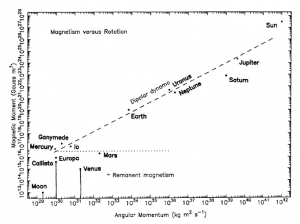2019年USAAAO决赛第10题
英文题目
10. (25 points) In this problem, we will try to understand the relationship between magnetic moments and angular momenta, first for charged particles and how this can be extended to planetary objects.
(a) (5 points) Consider a charge e and mass m moving in circular orbit of radius r with constant speed v. Write down the angular momentum L of the charge and magnetic moment µ of the effective current loop. Recall that the magnetic moment of a current loop with current I and radius r is given as $$µ=IA$$ where A is the area of the loop.
(b) (3 points) Use the above results to find a relationship between the magnetic moment µ and angular momentum L in terms of intrinsic properties of the particle (charge,mass).
(c) (2 points) The relationship from part (b) can be expressed as $$µ=γL$$. γ is usually referred to as the classical gyromagnetic ratio of a particle. Evaluate the classical gyromagnetic ratio for an electron and for a neutron in SI units.
(d) (7 points) For extended objects such as planets, the magnetic dipole moment is not directly accessible whereas the surface magnetic field can be measured. Assuming a magnetic dipole of magnetic moment µ located at the center of a sphere of radius r, write down the expression for the surface magnetic field $$B_{surf}$$ and the surface magnetic moment defined as $$\mathcal{M}_{surf}=B_{surf} r^3$$. You may use the value of the angular dependence at the magnetic equator for the following parts.
(e) (3 points) Assuming a gyromagnetic relationship exists between magnetic moment µ and angular momentum L of an extended object, write down the relationship between the surface magnetic moment $$\mathcal{M}_{surf}$$ and angular momentum L as $$\mathcal{M}_{surf} =\kappa L$$. You will observe that κ depends only on fundamental constants and intrinsic properties of the extended object.
(f) (3 points) The surface magnetic moments for Mercury and Sun are $$5 \times 10^{12} T m^3$$ and $$3 \times 10^{23} Tm^3$$ respectively. Assuming the bodies are perfect spheres, evaluate the constant κ for Mercury and the Sun. Comment on values obtained and if they fit into the model developed in parts (c) and (d).
(g) (5 points) The surface magnetic moments $$\mathcal{M}_{surf}$$ and angular momenta L of various solar system bodies are plotted in the figure 3. Justify that the data implies $$\mathcal{M}_{surf} \sim L^{\alpha}$$ and calculate the constant α. What is the expected value of α from the model developed in parts (c) and (d)?
(h) (2 points) Certain bodies such as Venus, Mars and the Moon are remarkably separated from the trend observed for other bodies. What can you say about magnetism in these bodies when compared to the others?
